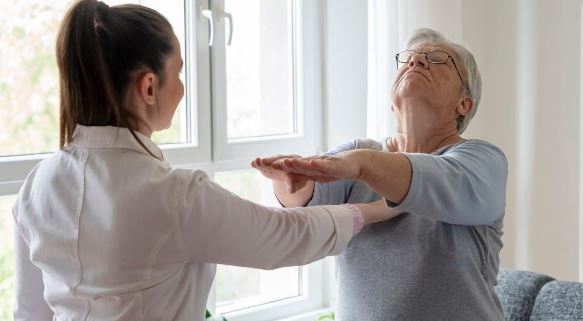Parkinson’s Disease and How Physical Therapy Can Help
Millions of individuals worldwide suffer from Parkinson’s disease (PD), a progressive neurological ailment. It primarily targets the brain’s dopamine-producing cells, leading to a range of motor and non-motor symptoms.
While there is no cure for Parkinson’s disease, various treatment approaches can help manage its symptoms and improve the quality of life for individuals with it. One such effective approach is physical therapy, which addresses motor symptoms and enhances functional independence.
This article will explore Parkinson’s disease, its impact on individuals, and how physical therapy can be a valuable intervention in managing this complex condition.
Understanding Parkinson’s Disease
Parkinson’s disease is named after Dr Parkinson. The illness was initially explained by James Parkinson in 1817. It primarily affects the basal ganglia, a group of structures in the brain responsible for regulating movement. Losing dopamine-producing cells in the substantia nigra lowers dopamine levels, causing tremors, stiffness, bradykinesia, and postural instability.
In addition to motor symptoms, individuals with Parkinson’s disease may experience non-motor symptoms, including cognitive changes, mood disorders, sleep disturbances, and autonomic dysfunction. As the disease progresses, daily activities become increasingly challenging, affecting physical and emotional well-being.
Parkinson’s Disease: The Function of Physical Therapy
Physical therapy is essential to a multidisciplinary approach to managing Parkinson’s disease. It focuses on addressing motor symptoms, improving functional capacity, and enhancing quality of life. A skilled physical therapist tailors treatment plans to meet the unique needs of each individual, considering their specific symptoms, stage of the disease, and personal goals.
1. Improving Motor Function
Physical therapy aims to improve motor function and mobility by addressing issues such as gait disturbances, balance problems, and muscle stiffness. Therapists use various techniques and exercises to help individuals maintain better control over their movements and enhance their ability to perform daily activities more easily.
2. Enhancing Balance and Stability
Balance impairments are common in Parkinson’s disease and can lead to an increased risk of falls. Physical therapists work on improving balance and stability through specific exercises that challenge the vestibular system and proprioception. Strengthening core muscles and practicing weight-shifting exercises are also essential in reducing the risk of falls and improving confidence in walking and other activities.
3. Addressing Gait Difficulties
Parkinson’s disease often affects gait, leading to shuffling steps, decreased arm swing, and festination (a tendency to walk faster and take small, quick steps). Physical therapy interventions focus on gait training, emphasizing proper foot placement, stride length, and coordinated arm movements to facilitate a more efficient and natural walking pattern.
4. Amplitude Training
Amplitude training is a specialized physical therapy technique to address bradykinesia and hypokinesia (reduced range of movement). This approach involves performing exaggerated, high-amplitude movements to increase the range of motion and improve the speed of movements.
5. Exercise for Strength and Flexibility
Maintaining muscle strength and flexibility is crucial for individuals with Parkinson’s disease. Physical therapists design targeted exercise programs to strengthen major muscle groups and increase joint flexibility. These exercises help counteract the muscle stiffness and rigidity commonly associated with the condition.
6. Cueing and Rhythmic Techniques
Cueing and rhythmic techniques are valuable tools for physical therapy for individuals with Parkinson’s disease. These techniques involve the use of external cues, such as auditory or visual cues, to help individuals initiate and maintain movements. Rhythmic auditory stimulation, for example, involves music to facilitate rhythmic and coordinated movements.
7. Functional Training
Functional training involves practicing tasks and movements relevant to daily life. By simulating real-life activities, individuals can improve their ability to carry out essential tasks independently.
8. Mental and Emotional Support
Living with Parkinson’s disease can be emotionally challenging. Physical therapists not only focus on the physical aspects of the condition but also provide emotional support to individuals and their caregivers. Encouragement and empathy from the therapist can positively impact the individual’s overall well-being.
9. Home Exercise Programs
Physical therapists often design home exercise programs tailored to an individual’s needs and abilities. These programs enable individuals to continue therapy outside the clinical setting, promoting ongoing progress and self-management.
10. Monitoring Progression and Adjusting Treatment
Parkinson’s disease is progressive, and symptoms may change over time. Physical therapists regularly assess the individual’s progress and adjust the treatment plan accordingly. By adapting therapy as needed, physical therapists ensure that interventions remain effective and relevant to the individual’s current needs.
Conclusion
Parkinson’s disease presents unique challenges to individuals, affecting their physical and emotional well-being. Physical therapy is a vital intervention that addresses motor symptoms, enhances mobility, and improves overall quality of life. Through specialized techniques, exercises, and emotional support, physical therapists empower individuals with Parkinson’s disease to lead more independent and fulfilling lives. Collaborating with a skilled physical therapist can make a significant difference in managing the complexities of Parkinson’s disease and embracing life with confidence and optimism.

